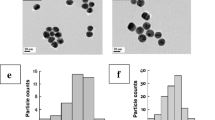Abstract
We describe a gold nanoparticle (AuNP)-based thermal history indicator (THI) for monitoring low-temperature storage. The THI was prepared from tetrachloroaurate using gelatin as a reducing reagent. Gelatin also acts as a stabilizer to control the growth of the AuNPs. The size and shape of the AuNPs were characterized by UV–vis spectrophotometry and transmission electron microscopy and are initially found to be spherical with an average particle size of ~19 nm. Initially, the color of the THIs is slightly pink, but after a 90-day storage in the freezer, as both the size and shape of the AuNPs change, the color of the THIs turns to red. After 90 days the absorbance peaks of THIs held at room temperature are red-shifted from 538 to 572 nm and possessed larger amplitude compared to those stored in the freezer. The color change is a function of both storage time and temperature. The observed increase in size is mainly due to storage temperature while the change in shape is mainly due to storage time. The THIs experiencing higher temperature treatments exhibit a more intense color change which is attributed to a localized surface plasmon resonance effect. Thus, the observed visual color changes can provide information regarding the thermal history the material has experienced. Accordingly, when used in conjunction with time-temperature sensitive products, the THI may serve as a proactive system for monitoring and controlling product quality and/or safety. For example, the THI is useful in safeguarding high-value biological products such as enzymes, antibodies, plasma, stem cells and other perishables that have to be stored at low temperatures.

Illustration of AuNPs size and shape evolution in thermal history indicators exposed to different storage times and temperatures. Generally, in our system, the size change is mainly due to storage temperature and the shape change due to storage time.






Similar content being viewed by others
References
Galmés A, Besalduch J, Bargay J, Novo A, Morey M, Guerra JM, Duran MA (1999) Long-term storage at −80 °C of hematopoietic progenitor cells with 5-percent dimethyl sulfoxide as the sole cryoprotectant. Transfusion 39:70–73
Moog R, Knopp D, Wenzel F (2010) Temporary storage of fresh frozen plasma above −30 °C has no negative impact on the quality of clotting factors and inhibitors. Transfus Altern Transfus Med 11:8–9
Derwood P, Aleksandar M (2007) Storage of hemopoietic stem cells. Asian J Transfus Sci 1(2):71–76
Hoffmann S, Batz MB, Morris JJG (2012) Annual cost of illness and quality-adjusted life year losses in the United States due to 14 foodborne pathogens. J Food Prot 75:1292–1302
Tao H, Brenckle MA, Yang M, Zhang J, Liu M, Siebert SM, Averitt RD, Mannoor MS, McAlpine MC, Rogers JA, Kaplan DL, Omenetto FG (2012) Silk-based conformal. Adhes Edible Food Sensors Adv Mater 24:1067–1072
Raviyan P, Tang J, Orellana L, Rasco B (2003) Physicochemical properties of a time-temperature indicator based on immobilization of aspergillus oryzaeα-amylase in polyacrylamide Gel as affected by degree of cross-linking agent and salt content. J Food Sci 68:2302–2308
Sing CE, Kunzelman J, Weder C (2009) Time-temperature indicators for high temperature applications. J Mater Chem 19:104–110
Kitsunai M, Miyajima K, Mikami Y, Kim S, Hirasawa A, Chiba K (2008) Phase-separable aqueous amide solutions as a thermal history indicator. Biosci Biotechnol Biochem 72:3314–3317
Wang X, Wolfbeis OS, Meier RJ (2013) Luminescent probes and sensors for temperature. Chem Soc Rev 42:7834–7869
Zhang C, Yin A-X, Jiang R, Rong J, Dong L, Zhao T, Sun L-D, Wang J, Chen X, Yan C-H (2013) Time–Temperature indicator for perishable products based on kinetically programmable Ag overgrowth on Au nanorods. ACS Nano 7:4561–4568
Won Y-W, Yoon S-M, Sonn CH, Lee K-M, Kim Y-H (2011) Nano self-assembly of recombinant human gelatin conjugated with α-tocopheryl succinate for Hsp90 inhibitor, 17-AAG. Deliv ACS Nano 5:3839–3848
Lim S, Gunasekaran S, Imm JY (2012) Gelatin-templated gold nanoparticles as novel time-temperature indicator. J Food Sci 77:N45–N49
Ray PC (2010) Size and shape dependent second order nonlinear optical properties of nanomaterials and their application in biological and chemical sensing. Chem Rev 110:5332–5365
Wang Y-C, Gunasekaran S (2012) Spectroscopic and microscopic investigation of gold nanoparticle nucleation and growth mechanisms using gelatin as a stabilizer. J Nanopart Res 14:1–11
Sardar R, Shumaker-Parry JS (2011) Spectroscopic and microscopic investigation of gold nanoparticle formation: ligand and temperature effects on rate and particle size. J Am Chem Soc 133:8179–8190
Petroski JM, Wang ZL, Green TC, El-Sayed MA (1998) Kinetically controlled growth and shape formation mechanism of platinum nanoparticles. J Phys Chem B 102:3316–3320
Burda C, Chen X, Narayanan R (2005) Chemistry and properties of nanocrystals of different shapes. Chem Rev 105:1025–1102
Wanihsuksombat C, Hongtrakul V, Suppakul P (2010) Development and characterization of a prototype of a lactic acid–based time–temperature indicator for monitoring food product quality. J Food Eng 100:427–434
Acknowledgments
Author Yi-Cheng Wang acknowledges funding from Wisconsin Distinguished Graduate Fellowship. The authors acknowledge the use of facilities and instrumentation supported by the University of Wisconsin Materials Research Science and Engineering Center (DMR-1121288).
Author information
Authors and Affiliations
Corresponding author
Electronic supplementary material
Below is the link to the electronic supplementary material.
ESM 1
(DOC 186 kb)
Rights and permissions
About this article
Cite this article
Wang, YC., Lu, L. & Gunasekaran, S. Gold nanoparticle-based thermal history indicator for monitoring low-temperature storage. Microchim Acta 182, 1305–1311 (2015). https://doi.org/10.1007/s00604-015-1451-6
Received:
Accepted:
Published:
Issue Date:
DOI: https://doi.org/10.1007/s00604-015-1451-6




